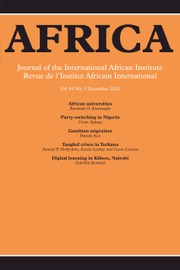No CrossRef data available.
Article contents
Pandemic masculinity: urban low-income men and the Covid-19 pandemic in Nigeria
Published online by Cambridge University Press: 28 February 2025
Abstract
In studies of violence against women and children during the Covid-19 pandemic, as well as in explanations of men’s increased vulnerability to the disease, the concept of ‘toxic masculinity’ regularly surfaces. However, direct research on men’s perspectives on the pandemic’s impact on them as men remains scarce. Drawing on interview data on urban Nigerian men’s lived experiences and narratives of the epidemic in relation to their identities and roles as men, I explore whether toxic masculinity was emblematic of men’s responses to the Covid-19 socio-economic crisis. While I found little evidence of the men’s reliance on toxic masculine practices to maintain their identities as men during the pandemic, their accounts revealed something quite significant: the reconstitution of masculine success in terms of the ability to adjust to the times by discontinuing practices that, while once essential to their identity as men, now threatened their image as capable providers. These adjustments, which frequently involved resorting to practices that would be considered unmanly, were constituted as part of the routine situational pivots that ‘real’ men must make, in keeping with their role as all-weather providers. I conclude with a reflection on how so-called non-heteronormative male performances might still mask gender inequalities and perpetuate certain aspects of patriarchal power.
Résumé
Dans les études sur la violence envers les femmes et les enfants pendant la pandémie de Covid-19, ainsi que dans les explications de la vulnérabilité accrue des hommes à cette maladie, le concept de « masculinité toxique » fait régulièrement surface. Cependant, les études directes sur les perspectives des hommes sur l’impact de la pandémie sur eux en tant qu’hommes restent rares. En s’appuyant sur des données d’entretiens sur les expériences vécues, et sur les récits de Nigérians urbains sur l’épidémie concernant leur identité et leur rôle en tant qu’hommes, l’auteur pose la question de savoir si la masculinité toxique était emblématique des réponses des hommes à la crise socioéconomique de la Covid-19. Bien que rien ou peu ne permette de prouver que ces hommes ont eu recours à des pratiques masculines toxiques pour maintenir leur identité en tant qu’hommes pendant la pandémie, leurs récits ont révélé quelque chose d’assez significatif : la reconstitution du succès masculin en termes de capacité à s’adapter à l’époque en abandonnant des pratiques qui, bien qu’autrefois essentielles à leur identité en tant qu’hommes, menaçaient désormais leur image de soutien de famille capable. Ces ajustements, qui impliquent souvent le recours à des pratiques considérées comme peu viriles, s’inscrivent dans les revirements situationnels habituels que les « vrais » hommes doivent opérer, en adéquation avec leur rôle de soutien de famille en toutes circonstances. L’auteur conclut par une réflexion sur la manière dont les comportements masculins dits non hétéronormatifs peuvent encore masquer les inégalités de genre et perpétuer certains aspects du patriarcat.
Resumo
Em estudos sobre a violência contra mulheres e crianças durante a pandemia de Covid-19, bem como em explicações sobre a maior vulnerabilidade dos homens à doença, o conceito de ‘masculinidade tóxica’ surge regularmente. No entanto, a investigação direta sobre as perspectivas dos homens relativamente ao impacto da pandemia sobre eles enquanto homens continua a ser escassa. Com base em dados de entrevistas sobre as experiências vividas por homens urbanos nigerianos e narrativas da epidemia em relação às suas identidades e papéis como homens, exploro se a masculinidade tóxica foi emblemática das respostas dos homens à crise socioeconómica da Covid-19. Embora tenha encontrado poucas evidências de que os homens tenham recorrido a práticas masculinas tóxicas para manterem as suas identidades como homens durante a pandemia, os seus relatos revelaram algo bastante significativo: a reconstituição do sucesso masculino em termos da capacidade de se ajustarem aos tempos, descontinuando práticas que, embora outrora essenciais para a sua identidade como homens, ameaçavam agora a sua imagem como provedores capazes. Estes ajustamentos, que frequentemente envolviam o recurso a práticas que seriam consideradas pouco masculinas, foram constituídos como parte da rotina de mudanças situacionais que os ‘verdadeiros’ homens têm de fazer, de acordo com o seu papel de provedores de tudo. Concluo com uma reflexão sobre a forma como os chamados desempenhos masculinos não heteronormativos podem ainda mascarar desigualdades de género e perpetuar certos aspectos do patriarcado.
- Type
- Pandemic masculinity
- Information
- Copyright
- © The Author(s), 2025. Published by Cambridge University Press on behalf of The International African Institute



